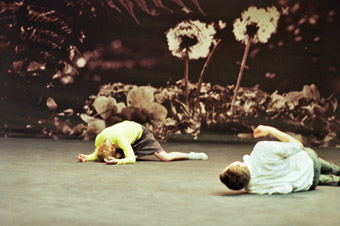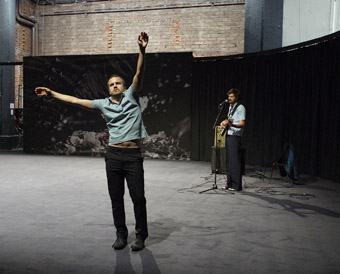 |
Maybe Forever, Meg Stuart, Philipp Gehmacher photo Chris van der Burght |
The stage of the Graha Bhakti Budaya auditorium is framed by semi-circular curtaining and is almost bare except for a low platform stage right, two microphones on stands, an electric guitar and a loudspeaker stage left, in addition to, upstage with a strong presence, a sepia photograph with two dandelions in focus against a background blur of trees. Stuart and Gehmacher begin with a slow duet amidst a brief series of low flashing lights. And that may be when the excitement graph rises to its highest. Stuart's subsequent monologue—sweet sentences abruptly changed by the end clause “I take that back”—fills in the back story of a break-up.
What’s remarkable throughout the 80-minute performance is Stuart and Gehmaher’s frequent shifts to and from and blending of stage acting and dance, as well as from everyday to choreographed movement—the combination never risks being labelled pedestrian. One repeated gesture is what Stuart calls “long arms” in which the performers extend their arms and hands as high as they can to wave at each other. It’s like a special code that means something dear to the couple when they’re together but is painful after the split.
The same smooth mix of performing arts disciplines—in addition to life and art itself—is also evident in Niko Hafkenscheid’s live guitar playing and singing and Vincent Malstaf’s music and sound design. The music and lyrics are as melancholic as the performance, and since Hafkenscheid directly addresses us, they are sung for both performers and audience. After calling our attention to the performance at the start, Jan Maertens’s lighting design simply, and subtly, gives the limelight to the performers. His masterful touch shows at the final moment when the lighting delicately changes the photograph’s colour tone.
Heraclitus had it right two and a half millennia ago: change is the only constant. It just seems to me that when it comes to contemporary relationships, we change much faster than our patience.
 |
Maybe Forever, Philipp Gehmacher, Niko Hafkenscheid photo Eva Wordinger |
One may argue that people go to performing arts events to experience what they cannot in real life—or, enough of early 20th century realism, please. In dance, they expect exceptional movement skills, for example. What they seem to forget is that sometimes we let life pass by without really thinking about it. Reconfirming that art is rooted in life, Maybe Forever allows us to do otherwise and hopefully, as we move on, not repeat a mistake, though knowing in the back of our minds that we probably will.
Maybe Forever is on a Southeast Asian and Australian tour, organized by the Goethe Institut, despite the fact that none of the artists are German (though Stuart is Berlin-based). Unfortunately, the only part of our country it crossed was the Gulf of Thailand last week on the group's flight from Ho Chi Minh City to Singapore. Maybe Forever would have been a sizeable dance top-up for Bangkok audiences after the visit of Xavier Leroy last November.
10th Indonesian Dance Festival: Damaged Goods & Mumbling Fish, Maybe Forever, choreography & dance Meg Stuart, Philipp Gehmacher, live music: Niko Hafkenscheid, dramaturgy Miriam van Imschoot, lighting Jan Maertens, scenography, costumes Janina Audick, music, sound Vincent Malstaf; Graha Bhakti Budaya, Taman Ismail Marzuki, Jakarta, June 16
© Pawit Mahasarinand; for permission to reproduce apply to [email protected]








 back
back